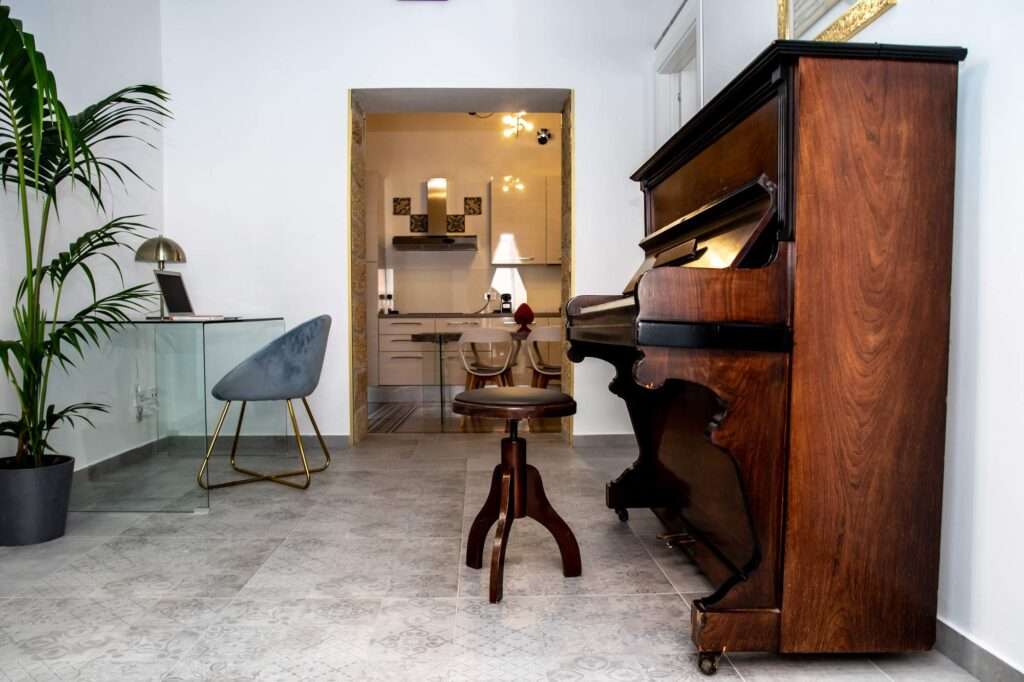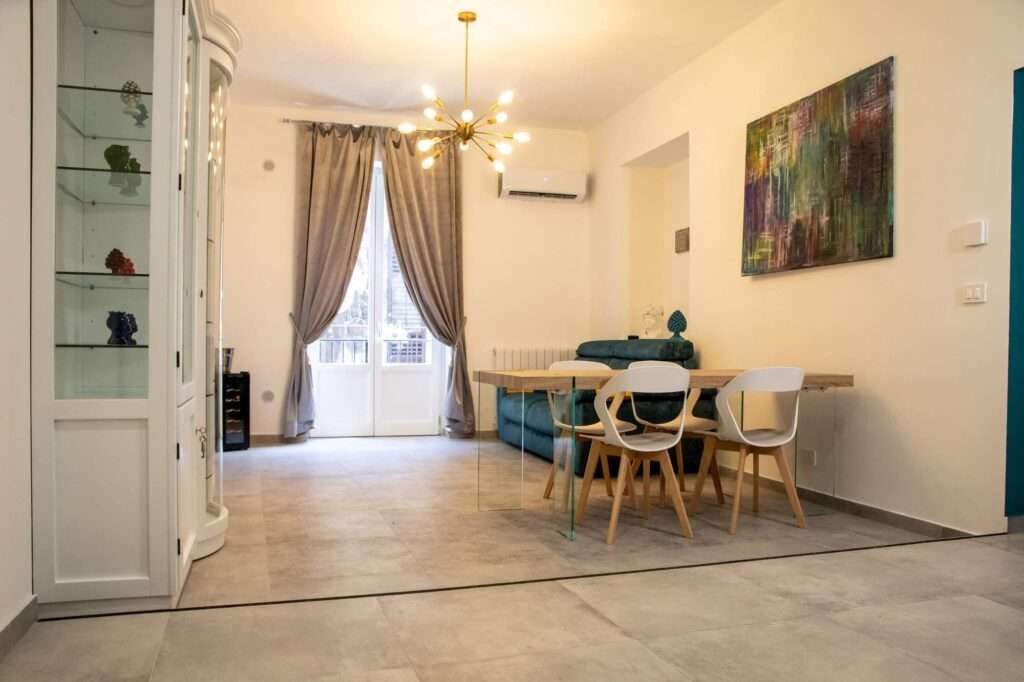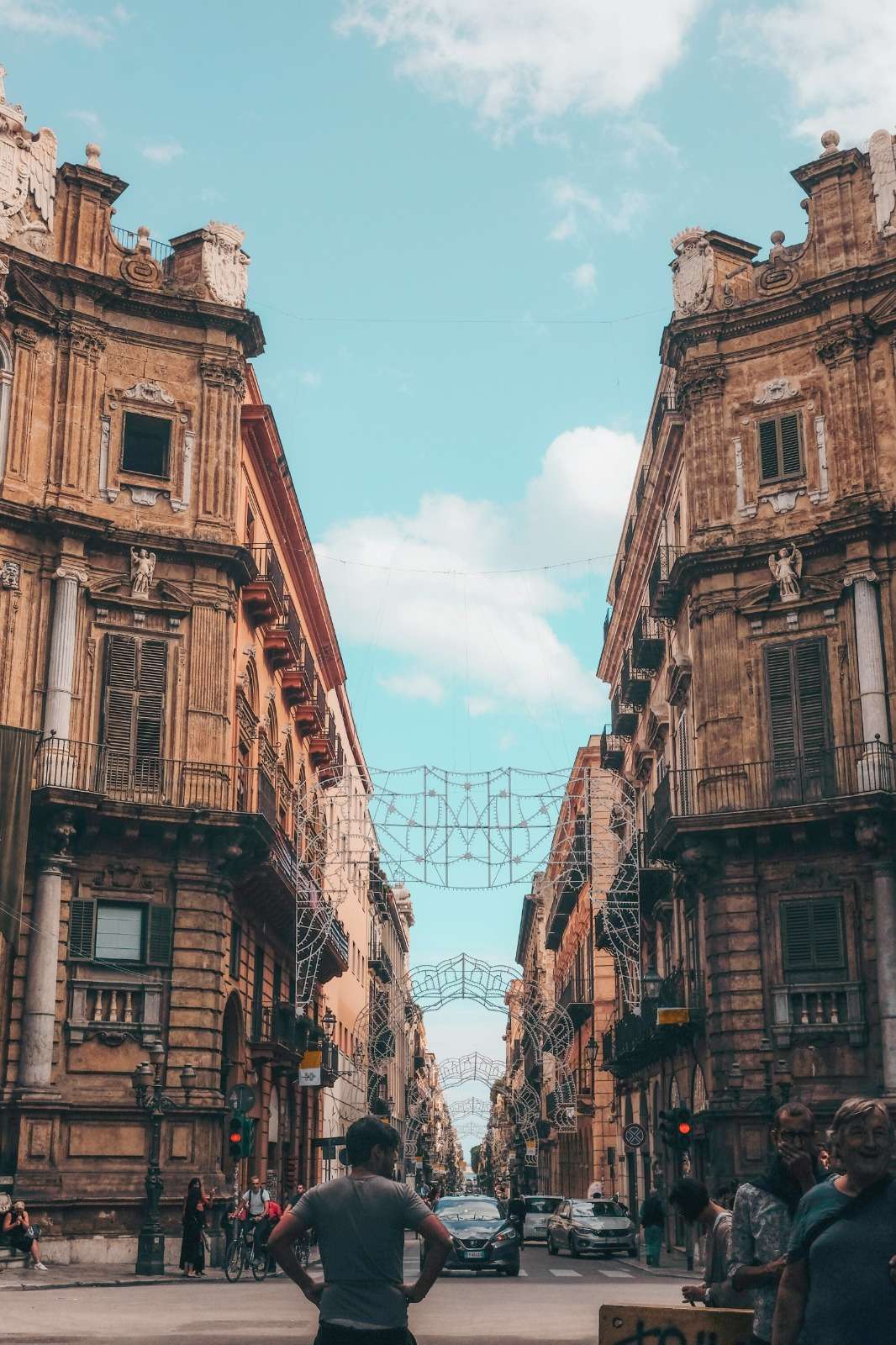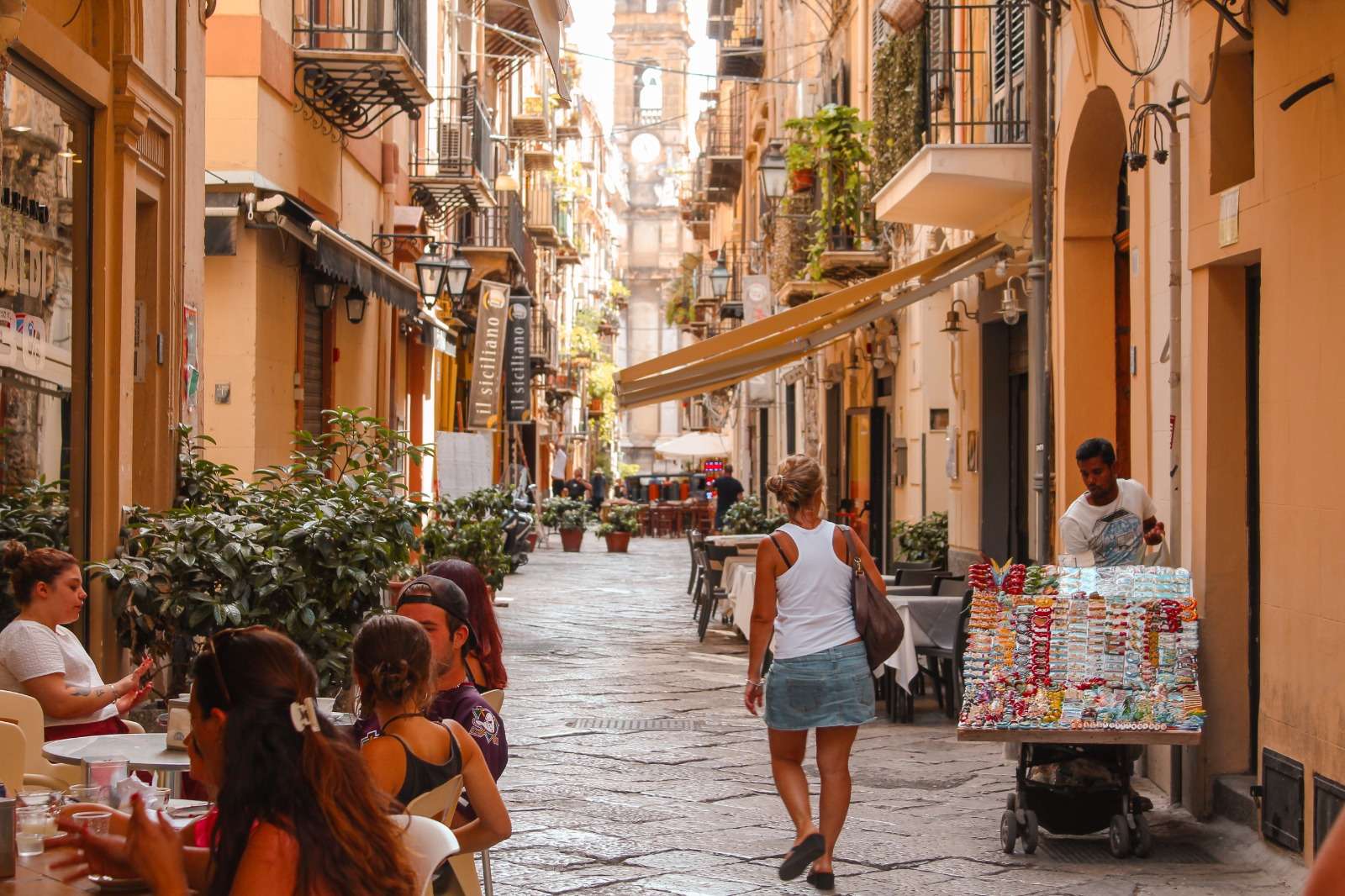Luxury Apartments in Palermo
Casta Diva Apartments
Luxury Apartments in Palermo
Casta Diva Apartments
Discover the pleasure and the suggestion of sleeping in the center of Palermo. Choose one of our luxury apartments!
In the heart of the beautiful city of Palermo, In via Maqueda one of the most prestigious and rich in history pedestrian courses, there is a building from the 1600’s made known by the master Vincenzo Bellini who stay in 1832.
Casta diva luxury apartments takes its name from one of the most important works of the composer and angel of music.
The buildings are located on the first floor of the building, overlooking Via Maqueda they have been recently renovated and designed to ensure the most comfort exclusive, characterized by elegance and charm.
APARTMENTS
Vittoria Apartment
The Vittoria suite is an elegant apartment, with luxurious finishes, of approx 85 square meters; three rooms all with balconies, two overlooking via Maqueda. The property is characterized by a decorated wooden coffered roof from the 1600s in the kitchen-living area and a vault decorated from the same period in the beautifully restored bedroom and study area.
from €90
Chiara Apartment
The SUITE CHIARA is an elegant apartment, with luxurious finishes, of approx 70 square meters; two rooms all with balconies.
The property features a decorated wooden coffered roof from the 1600s in the sleeping area restored to perfection. Of course, everyone is there the essential elements of comfort: king size double bed, a sofa bed. bedside
tables, table with chairs.
from €75
Ginevra Apartment
The GENEVA suite is an elegant apartment with luxurious finishes, of
about 70 square meters; two rooms with four balconies that give great
brightness. The property is characterized by a carefully chosen furniture and an area “Chill out” where you can spend moments in absolute relaxation.
from €75
Are you thinking of staying in Palermo?
Choose Casta Diva Apartments.
THE CHURCH OF THE MARTORANA
BACKGROUND
The origins of the Martorana Church date back to the 12th century. It was founded by the will of George of Antiochia, admiral of the fleet of King Ruggero II of Altavilla to thank the Virgin Mary for the protection she had granted him during all the years spent at sea. The layout of the original church was in the form of an inscribed cross, typical of late Byzantine churches and in line with the intended use for the Greek Byzantine cult desired by George of Antioch. The current appearance is the result of works and renovations over the centuries, in particular the additions in the Baroque period and the drastic restoration by Giuseppe Patricolo at the end of the nineteenth century should be remembered. Today the church belongs to the Eparchy of Piana degli Albanesi, a Catholic diocese with a Greek – Byzantine rite: it is a community that, although belonging to the Catholic Church, follows the rite and traditions of the Eastern Orthodox Church, a cult introduced in Sicily by the Albanians who took refuge here to escape Turkish persecutions.
THE 4 CANTI
BACKGROUND
Having taken over the government of the city and the island in 1606, the viceroy, two years later, entrusted the Florentine architect Giulio Lasso with the urban planning of the square, which he worked on for many years. The project was inspired by the crossroads of the Quattro Fontane in Rome, designed by the urban planners of Pope Sixtus V in much more modest forms than the later Palermo version.
In 1609 the structural part of the two cantons later known as Santa Ninfa and Sant’Agata, which bear the coats of arms of Viceroy Vigliena, must have already been completed. In 1612 the canton of Santa Cristina was complete, adhering to San Giuseppe, promoted by the viceroy Ossuna. In 1615 Giulio Lasso was already dead and from 1617 Mariano Smiriglio, engineer of the Senate and former supervisor of the construction site during the direction of the Lasso, has been director of works.
On 2 August 1630, the works for the factory of the four fountains with the statues of the Four Seasons were contracted, also planned in bronze and then made in marble: the Spring and Summer were made by Gregorio Tedeschi; Autumn and Winter by Nunzio La Mattina. The current lower basins of the four fountains are from the nineteenth century and were built to compensate for the difference in height created in the floor of the square which had been lowered due to the leveling of the street. The “Quinto Canto” which can be seen on Via Vittorio Emanuele and is part of the right facade of the Church of San Giuseppe dei Teatini was decorated in 1844.
IN PALERMO THE CENTER IS HISTORICAL
BACKGROUND
The historic center of Palermo is divided into four historic districts called mandamenti: Kalsa, Albergheria, Seralcadio and La Loggia.
Currently the districts correspond to the first 4 units of the first level of Palermo.
This subdivision dates back to the urban changes introduced by the Spanish rulers between the sixteenth and seventeenth centuries: it was the construction of via Maqueda which, longitudinally cutting the Cassaro divided the urban space into four areas.
Each district had its own patron saint (until 1624, the year in which Santa Rosalia became the patron saint of the entire city) and her own coat of arms:
The Kalsa also known as Mandamento Tribunali had Sant’Agata as its patron saint and its coat of arms was the rose flower
The Albergheria (or Mandamento Palazzo Reale) had Santa Cristina as its patron and its coat of arms was a green snake on a gold field
The Seralcadio (or Mandamento Monte di Pietà) had Santa Ninfa as its patron and its coat of arms was Hercules landing the lion
The Loggia (or Mandamento Castellammare) had Sant’Oliva as its patron saint and its coat of arms was that of the royal house of Austria
It is the smallest and oldest district of the city of Palermo, the land is characterized by a slight slope slightly sloping towards the sea, where there is a natural port, now used as a tourist port (la Cala). In the past it was divided by two rivers, the Kemonia and the Papireto, buried and partly diverted towards the Oreto river. The subsoil is composed almost exclusively of materials accumulated over the centuries at the mouth of the two rivers.
It is enclosed within a quadrilateral of streets that trace, in part, the moats of the old city walls.
APARTMENTS
Vittoria Apartment
The Vittoria suite is an elegant apartment, with luxurious finishes, of approx 85 square meters; three rooms all with balconies, two overlooking via Maqueda. The property is characterized by a decorated wooden coffered roof from the 1600s in the kitchen-living area and a vault decorated from the same period in the beautifully restored bedroom and study area.
from €90
Chiara Apartment
The SUITE CHIARA is an elegant apartment, with luxurious finishes, of approx 70 square meters; two rooms all with balconies.
The property features a decorated wooden coffered roof from the 1600s in the sleeping area restored to perfection. Of course, everyone is there the essential elements of comfort: king size double bed, a sofa bed. bedside
tables, table with chairs.
from €75
Ginevra Apartment
The GENEVA suite is an elegant apartment with luxurious finishes, of
about 70 square meters; two rooms with four balconies that give great
brightness. The property is characterized by a carefully chosen furniture and an area “Chill out” where you can spend moments in absolute relaxation.
from €75
THE CHURCH OF THE MARTORANA
BACKGROUND
The origins of the Martorana Church date back to the 12th century. It was founded by the will of George of Antiochia, admiral of the fleet of King Ruggero II of Altavilla to thank the Virgin Mary for the protection she had granted him during all the years spent at sea. The layout of the original church was in the form of an inscribed cross, typical of late Byzantine churches and in line with the intended use for the Greek Byzantine cult desired by George of Antioch. The current appearance is the result of works and renovations over the centuries, in particular the additions in the Baroque period and the drastic restoration by Giuseppe Patricolo at the end of the nineteenth century should be remembered. Today the church belongs to the Eparchy of Piana degli Albanesi, a Catholic diocese with a Greek – Byzantine rite: it is a community that, although belonging to the Catholic Church, follows the rite and traditions of the Eastern Orthodox Church, a cult introduced in Sicily by the Albanians who took refuge here to escape Turkish persecutions.
THE 4 CANTI
BACKGROUND
Having taken over the government of the city and the island in 1606, the viceroy, two years later, entrusted the Florentine architect Giulio Lasso with the urban planning of the square, which he worked on for many years. The project was inspired by the crossroads of the Quattro Fontane in Rome, designed by the urban planners of Pope Sixtus V in much more modest forms than the later Palermo version.
In 1609 the structural part of the two cantons later known as Santa Ninfa and Sant’Agata, which bear the coats of arms of Viceroy Vigliena, must have already been completed. In 1612 the canton of Santa Cristina was complete, adhering to San Giuseppe, promoted by the viceroy Ossuna. In 1615 Giulio Lasso was already dead and from 1617 Mariano Smiriglio, engineer of the Senate and former supervisor of the construction site during the direction of the Lasso, has been director of works.
On 2 August 1630, the works for the factory of the four fountains with the statues of the Four Seasons were contracted, also planned in bronze and then made in marble: the Spring and Summer were made by Gregorio Tedeschi; Autumn and Winter by Nunzio La Mattina. The current lower basins of the four fountains are from the nineteenth century and were built to compensate for the difference in height created in the floor of the square which had been lowered due to the leveling of the street. The “Quinto Canto” which can be seen on Via Vittorio Emanuele and is part of the right facade of the Church of San Giuseppe dei Teatini was decorated in 1844.
IN PALERMO THE CENTER IS HISTORICAL
BACKGROUND
The historic center of Palermo is divided into four historic districts called mandamenti: Kalsa, Albergheria, Seralcadio and La Loggia.
Currently the districts correspond to the first 4 units of the first level of Palermo.
This subdivision dates back to the urban changes introduced by the Spanish rulers between the sixteenth and seventeenth centuries: it was the construction of via Maqueda which, longitudinally cutting the Cassaro divided the urban space into four areas.
Each district had its own patron saint (until 1624, the year in which Santa Rosalia became the patron saint of the entire city) and her own coat of arms:
The Kalsa also known as Mandamento Tribunali had Sant’Agata as its patron saint and its coat of arms was the rose flower
The Albergheria (or Mandamento Palazzo Reale) had Santa Cristina as its patron and its coat of arms was a green snake on a gold field
The Seralcadio (or Mandamento Monte di Pietà) had Santa Ninfa as its patron and its coat of arms was Hercules landing the lion
The Loggia (or Mandamento Castellammare) had Sant’Oliva as its patron saint and its coat of arms was that of the royal house of Austria
It is the smallest and oldest district of the city of Palermo, the land is characterized by a slight slope slightly sloping towards the sea, where there is a natural port, now used as a tourist port (la Cala). In the past it was divided by two rivers, the Kemonia and the Papireto, buried and partly diverted towards the Oreto river. The subsoil is composed almost exclusively of materials accumulated over the centuries at the mouth of the two rivers.
It is enclosed within a quadrilateral of streets that trace, in part, the moats of the old city walls.
Food & Drink
The rediscovery of Sicilian food
THE SICILIAN CANNOLO
The Sicilian cannoli is one of the best known specialties of Sicilian pastry.
THE SFINCIA DI SAN GIUSEPPE
The sfincia di San Giuseppe indicates a fried dessert typical of Sicily, which combined with fresh ricotta becomes a unique delicacy.
THE SICILIAN CASSATA
Among the desserts that have made Sicily famous in the world, a privileged place belongs to the Sicilian Cassata. A true triumph of sponge cake, ricotta, marzipan and candied fruit. A mix of colors and flavors that amaze the eyes and the palate.
Appartamenti e suite di lusso a Palermo
Luxury apartments and suites could not be defined as such if they did not have all the most advanced comforts available. In each structure there are all the essential elements of comfort: king size double bed, sofa bed, bedside tables, table with chairs and desk with armchair. Comfort and luxury can also be seen in the extremely refined furnishings, you will even find an antique piano inserted to create a relaxing and exclusive environment. The kitchens are complete and equipped with an induction cooking surface, as well as all dishes. In the rooms there is also a Nespresso coffee machine with welcome capsules, a well-stocked wine cellar and all the most modern technology: high-speed Wi-Fi, 4K smart TV and much more. The bathrooms are elegant and well-kept, all equipped with shower, hairdryer and courtesy kit. Each of our guests deserves to spend a luxurious stay in our apartments and suites in Palermo.
Review
Vivere Palermo in tale confort è stata una bellissima esperienza, le suite sono fantastiche!
Palermo è una città fantastica, e con il supporto del personale abbiamo conosciuto ristoranti fantastici. Grazie di tutto!
La nostra esperienza in appartamento è stata fantastica, host cordiali e disponibili.
Beautiful place in Palermo. I love it.
Apartment
Amenities
WiFi
Smart TV
Air Conditioning
Safe
Coffee machine
Kettle
Netflix & Alexa
Courtesy kit
Hairdryer
Kitchen with fridge
Balcony with a view
King size Bed
Do you think we are the right structure for you?
Call Now to book
Information
Frequently asked questions
When can I check-in?
Check-in from 15:00 to 00:00.
Do guests receive the courtesy kit?
Yes, each guest will receive the courtesy kit.
Does the property have a parking space?
The hotel has a paid parking lot.
Is there a Wi-Fi connection?
Yes, the property has a high-speed wifi connection. Ideal for those who have to work even during the holiday.
When is the Check-out done?
Check-out from 8:30 to 10:00.
What are you doing about Covid-19?
The apartments are sanitized and disinfected following the anti covid-19 health regulations.
Are the city monuments near structure?
The structure is in the historic center of Palermo, and therefore close to the most important monuments of Palermo such as: the maximum theater, Piazza della Vergogna and many other historical monuments.
Visit Palermo
Stay in style!
If you are in Palermo for business or leisure and you want to stay in a luxury environment, you must choose our apartments and our suites.







